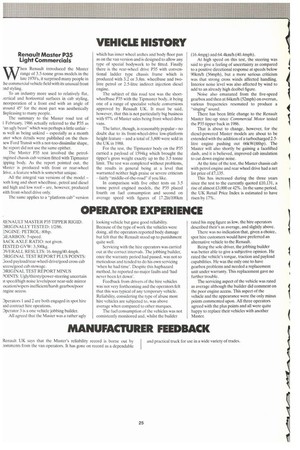VEHICLE HISTORY
Page 167

If you've noticed an error in this article please click here to report it so we can fix it.
Renault Master P35 Light Commercials When Renault introduced the Master range of 3.5-tonne gross models in the late 1970's, it surprised many people in he commercial vehicle field with its unusual front :ad styling. To an industry more used to relatively flat, iertical and horizontal surfaces in cab styling, ncorporation of a front end with an angle of tround 45° for the most part was aesthetically iispleasing to many people. The summary to the Master road test of L February, 1986 actually referred to the P35 as 'an ugly beast' which was perhaps a little unfair is well as being unkind especially as a month ater when details were published on the thentew Ford Transit with a not-too-dissimilar shape, :he report did not use the same epithet. The Master P35 test involved the petroltheined chassis cab version fitted with Tipmaster :ipping body. As the report pointed out, the Vlaster is produced with front or rear-wheel Irive, a feature which is somewhat unique. All the integral van versions of the model ioth long and short wheelbase, petrol and diesel Ind high and low roof are, however, produced Nith front-wheel drive only.
The same applies to a -platform cab" version which has inner wheel arches and body floor pan as on the van version and is designed to allow any type of special bodywork to be fitted. Finally there is the rear-wheel drive P35 with conventional ladder type chassis frame which is produced with 3.2 or 3.8m. wheelbase and twolitre petrol or 2.5-litre indirect injection diesel engine. The subject of this road test was the shortwheelbase P35 with the Tipmaster body, it being one of a range of specialist vehicle conversions approved by Renault UK. It must be said, however, that this is not particularly big business with 97% of Master sales being front wheel drive vans.
The latter, though, is reasonably popular no doubt due to its front-wheel-drive low-platform height feature and a total of 3,600 were sold in the UK in 1988.
For the test, the Tipmaster body on the P35 carried a payload of 1594kg which brought the tipper's gross weight exactly up to the 3.5 tonne limit. The test was completed without problems, the results in general being at a level that warranted neither high praise or severe criticism fairly "middle-of-the-road" if you like. In comparison with five other tests on 3.5 tonne petrol engined models, the P35 placed fourth on fuel consumption and second on average speed with figures of 17.21it/100km (16.4mpg) and 64,4km/b (40.4mph). At high speed on this test, the steering was said to give a feeling of uncertainty as compared to a positive directional response at speeds below 90km/h (56mph), but a more serious criticism was that strong cross winds affected handling. Interior noise level was also affected by wind to add to an already high decibel figure.
Noise also emanated from the five-speed gearbox and then at 84km/h (52mph) on overrun, various frequencies resonated to produce a "singing" sound. There has been little change to the Renault Master line-up since Commercial Motor tested the P35 tipper back in 1986.
That is about to change, however, for the diesel-powered Master models are about to be extended with the addition of a turbocharged 2.5litre engine pushing out 66kW(88hp). The Master will also shortly he gaining a facelifted dash, and it is believed, improved cab insulation to cut down engine noise. At the time of the test, the Master chassis cab with petrol engine and rear wheel drive had a net list price of £7,135. This has increased during the three years since the test to the currently quoted £10,131, a rise of almost £3,000 or 42%. In the same period, the UK Retail Price Index is estimated to have risen by 17%.














































































































































































